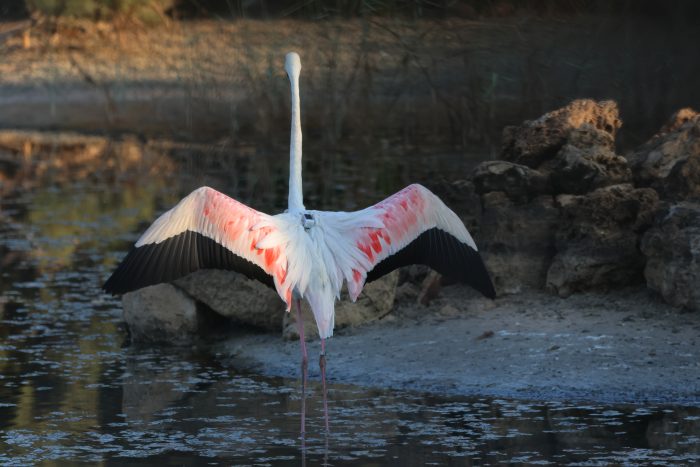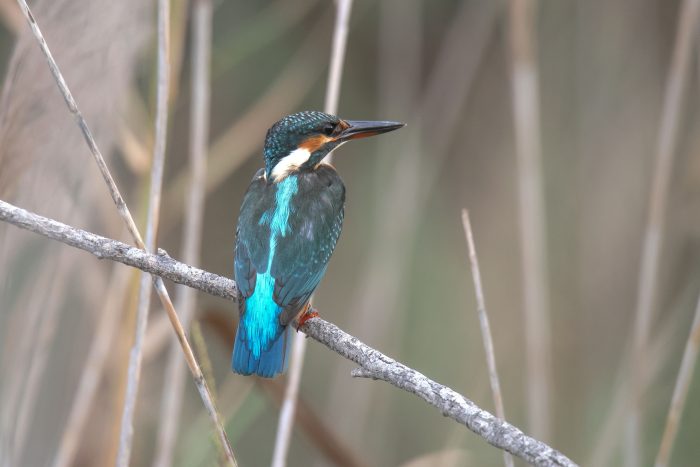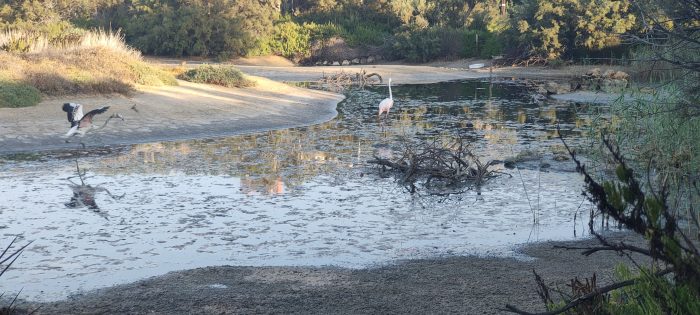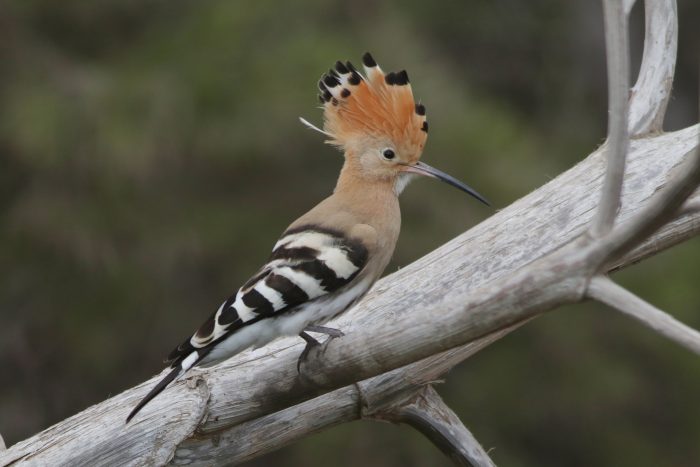On the frontlines is our monthly newsletter section covering the activities of BirdLife Malta’s conservation, policy and nature reserve (Salina, Simar, Għadira and Foresta 2000) teams, together with an update about rare and scarce bird species observed.

Fellow Flamingos in Għadira Nature Reserve
This month we successfully released 2 flamingos in Għadira Nature Reserve. The first one, named Fiona, was illegally kept in captivity and confiscated in July 2023 thanks to a tip that BirdLife Malta received. The bird was most likely caught when juvenile then grew up in a captive environment and may have lost some of its wild instincts. The release into the reserve allows us to observe its behaviour and understand its ability to cope with migration. Fiona has also been fitted with a GPS transmitter, which enables us to track her flight tests in the reserve and the migration path when she will choose to leave the reserve.
Not many days after Fiona’s release, another flamingo was spotted in Gozo weak and tired after its migration, was recently collected by the Environmental Protection Unit (EPU). After spending nine days in rehabilitation, where it gained strength and weight, the bird was then released and joined Fiona. In the meantime, a third juvenile flamingo just landed in Għadira to rest and recover the energy spent during the migration from the North. We wish these 3 flamingos a quick return to fitness for their migration to the wintering grounds to other coastal lagoons.

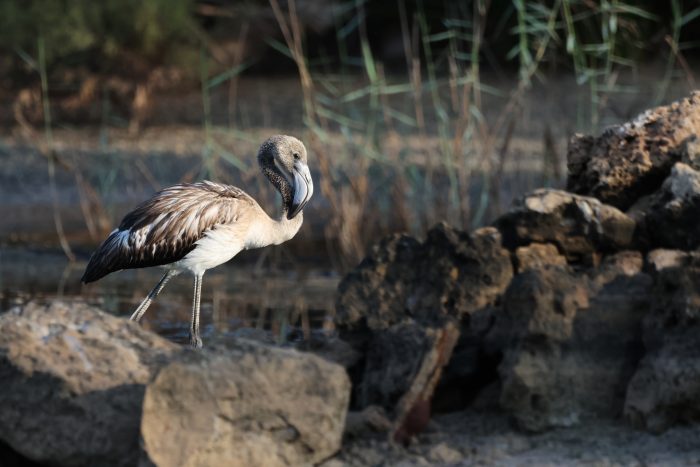

During this month we also successfully achieved a complete rehabilitation of 2 Yelkouan Shearwater, weak and covered with oil and 2 Yellow-legged Gull of which one was caught by a fishing line. All these birds have now returned to the wild.
Wader hunter busted
It is convenient for hunters to hunt at this time of year, targeting other species, if they have a rabbit hunting licence.
This month, a Conservation department team reported a hunter for protected bird species during the closed season. The man mentioned above was targeting wader species with the use of electronic callers and plastic decoys at the coastal area of Qalet Marku. Environmental Protection Unit (EPU) officers intervened and apprehended the hunter in action, with an investigation and a court case expected.
Rabbit hunting is seldom practiced on the coastline and the season is open between 1st June and 31st December. The hunting season for birds only opens from the 1st of September.
Should you happen to take a walk along the coast or along the fields and notice a hunter using bird decoys and callers, he certainly has no intention of hunting rabbits. Please report to BirdLife Malta on 2134 7645 or on the emergency (out of office hours) number 7925 5697. Illegalities may also be reported to police on 119 asking to be transferred through to the EPU.
Start of the hunting season and Raptor Camp
The autumn hunting season is now officially opened. The season will be open until the end of January.
Hunters can shoot from two hours before sunrise until 19:00 on Monday through Saturday and until 13:00 on Sundays and public holidays throughout the hunting season. For more information you can visit our website here.

Salina Nature Reserve
Sightings
As expected, migration picked up pace with small groups of waders from various species arriving and departing swiftly. These included Dunlins, Curlew Sandpiper, Little and Temminck’s Stints, Black-winged Stilt, Common Sandpiper, Little Ringed Plover and Common Ringed Plover. Several flocks of migrating Grey Heron, Purple Heron, Little Egret and Night-heron were observed, with some individuals remaining in the reserve for several days.
Kingfishers were notably active, engaging in frequent territorial disputes, especially with each new arrival. Small numbers of passerines were also recorded, including Great Reed-warbler, Common Reed-warbler, Sedge Warbler, Subalpine Warbler and Yellow Wagtail. A rather unusual sighting for this time of the year was a Black-necked Grebe, which is more commonly seen later in the year. The true highlight of the month was a splendid flock of Glossy Ibis that flew over the reserve and one that spent some time feeding in the saltpans.


Works and visits
Progress continued on the new photography hide, which is expected to offer excellent opportunities for viewing gull species by November. Additionally, work proceeded on reinforcing the wooden handrail along the main footpath and improving the fencing near the new hide.
In the wetlands, regular irrigation of the recently planted saplings persisted, while overgrown Tamarisk trees were pruned. During renovations in the security office, insect damage was discovered in a wooden beam. To address this, the affected area was thoroughly exposed and treated with appropriate materials, with further treatments planned to prevent any future damage.
Għadira Nature Reserve
Sightings
During the month of August, several sightings of autumn migrants were recorded at Għadira Nature Reserve, including Hoopoes, Yellow Wagtails, and a variety of wader species. Reed Warblers and Subalpine Warblers were present throughout the month, along with notable observations of a Sanderling that stayed briefly in the reserve.
A particularly eventful day saw the appearance of two Water Rails and a Spotted Crake. Green Sandpipers reached a peak count of 11 individuals, while Wood Sandpipers numbered 30. A Little Bittern was also observed around the same period. A roost count of Spanish Sparrows mid-month revealed over 600 individuals.
In other significant events, an adult Flamingo was released back into the wild and was soon joined by a young wild Flamingo. Two male Ruffs were spotted alongside the release of another rehabilitated Flamingo. Flocks of Night Herons and Grey Herons were a common sight, and two Purple Herons were seen flying overhead later in the month. The last nesting pair on the West Pebble Island successfully fledged at least two chicks, marking the end of the nesting season at the reserve.
Little Stints were seen regularly in small numbers, and Temminck’s Stint made a brief appearance. Ringed Plovers, Curlew Sandpipers, and Dunlins were also recorded in small numbers throughout the month.
Works
Following the demolition of the old bird-hide in the end of July, construction of the new observation hide started in mid-August with the laying of foundations. Any concrete soiling along the pathways during the construction process was manually removed, and strict safety measures were maintained throughout the process.
In addition to the hide construction, much of the work at the reserve focused on the tree nursery. Weeding and transplanting of seedlings were carried out as needed. Irrigation and replenishment of freshwater ponds was done twice to three times weekly due to the lack of rainfall during the month. Bird sightings were logged daily and inputted in the database. The Burrowing sand cricket survey was conducted on a weekly basis throughout the month.
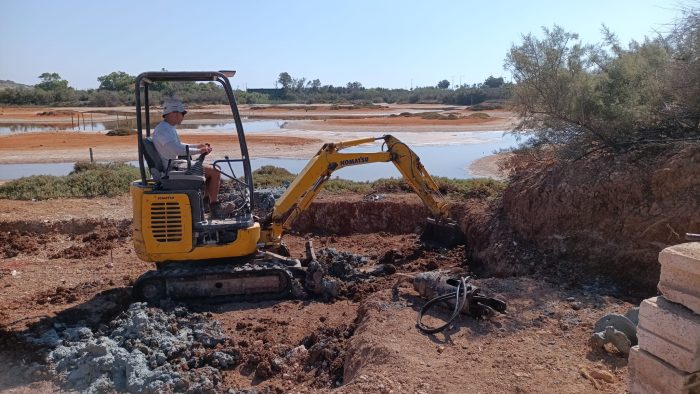

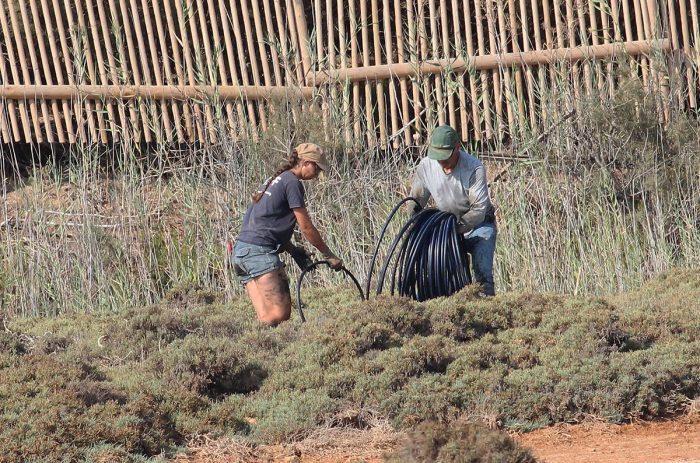
Simar Nature Reserve
Sightings
The low water levels in the wetland continued to expose more shorelines and mudflats. This created a habitat ideal for both shorebirds and waterbirds. And with the expansion of more reedbeds, various other wetland bird species were attracted.
A good number of wader species were present throughout the month. The most common were Common Sandpipers, whilst Little Ringed Plovers and Little Stints were also seen in good numbers. Wood Sandpipers were regularly seen but in smaller numbers, as well as the occasional Green Sandpiper and Ringed Plover. A flock of 16 Black-winged Stilts spent a day feeding and resting in the newly formed mudflats.
Early in the month, a flock of eight Squacco Herons settled in the reserve before departing on that same day at dusk. Later on, during the month a few flocks of Night-herons also roosted in the reserve as well as a few Purple Herons and Grey Herons. Flocks of Little Egrets were regularly present. Some ducks were also occasionally seen including 3 Eurasian Teal and a female Northern Shoveler. Also, a flock of 17 Glossy Ibises flew over.
During a bird ringing session, a Great Reed-warbler with a Hungarian ring was handled and eventually released. Bird ringing at Simar is a scientific tool used to help us understand better the avian life history including migration. Other birds present in the reserve, mainly in the wetland area, included Reed-warblers and Sedge Warblers. Also present were Subalpine Warblers and Garden Warblers.

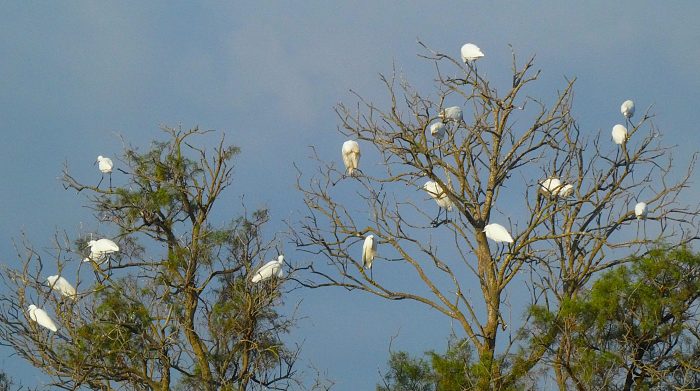
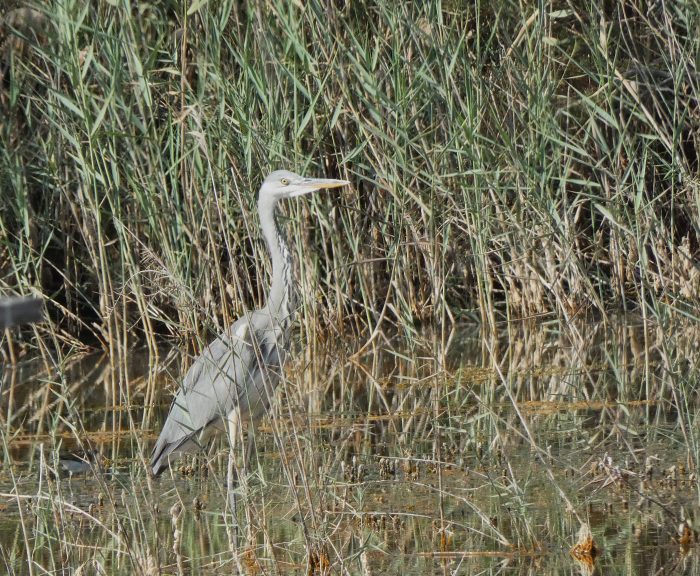
Works
Most of the works carried out this summer are gradually being finalised. The new paths with the wooden railings are now almost ready. Extensive alien vegetation clearing and shredding was continued on one of the Tamarisk islands. But works had to be halted due to the eventual arrival of the first migratory herons which normally roost in this area.
Foresta 2000
Sightings
August as always has brought us intense sunshine, leaving Foresta 2000 dry and golden under the summer heat. Despite the lack of rain even after Santa Maria, there’s still been plenty of wildlife to enjoy as we look forward to the autumn migration.
Early in the month, the first European Hoopoe of the season was spotted, hovering just above the steppe area. Common Swifts have been zipping through the air, and clouds of Spanish Sparrows are a common sight, while the familiar cooing of Collared-doves adds to the summer soundtrack. Towards the end of August, flocks of Herons were seen flying high overhead.
Meanwhile, Scarlet Darter (Broad Scarlet) dragonflies have added a burst of colour to the reserve—their males, a vivid red, and the females, a striking bronze. Blue Rock-thrushes have also been seen frequently, bringing their characteristic song to the reserve. Keep an eye out for Spectacled Warblers on the garigue areas and Wheatears as they’re expected to arrive in the reserve soon.
Works
Weekly clean-ups and area checks have been done, ensuring that Foresta 2000 remains a welcoming place for both its wildlife and visitors.
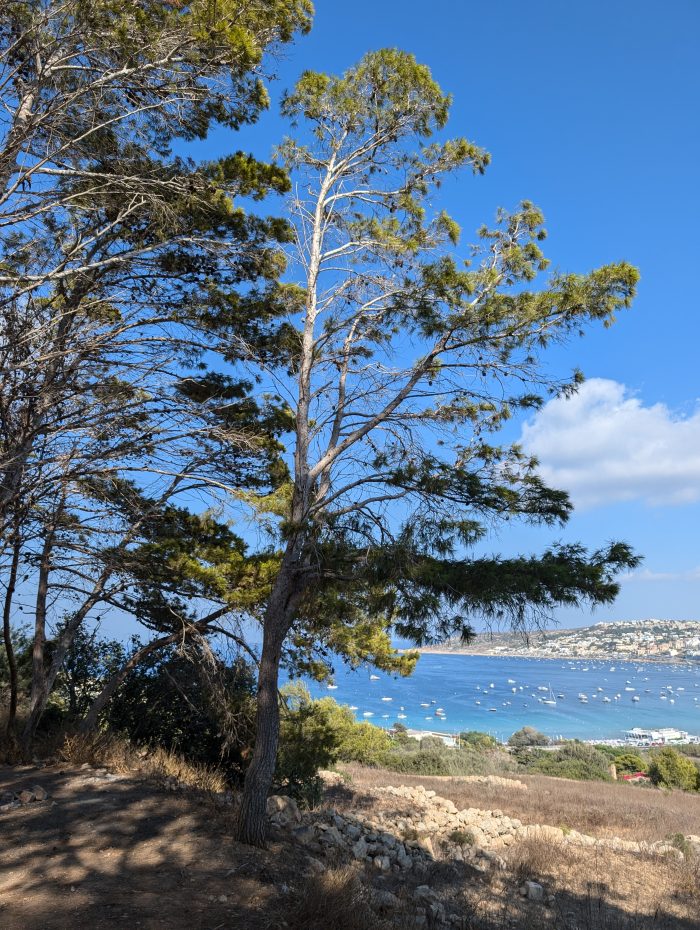


BirdLife Malta Objects to a Residential Development Near Protected Valley System of Wied il-Għasel
BirdLife Malta has formally objected to a planning application (PC/00045/23) that seeks to rezone 1,700m2 of land for a residential terraced development. The proposal includes a three-story building with a semi-basement and modifications to the building’s alignment to extend the existing public road. This site, which had previously been issued an enforcement notice for illegal garage construction, later sanctioned by the Planning Authority, is located next to the protected Wied il-Għasel valley system, designated as an Area of Ecological Importance and Site of Scientific Importance.
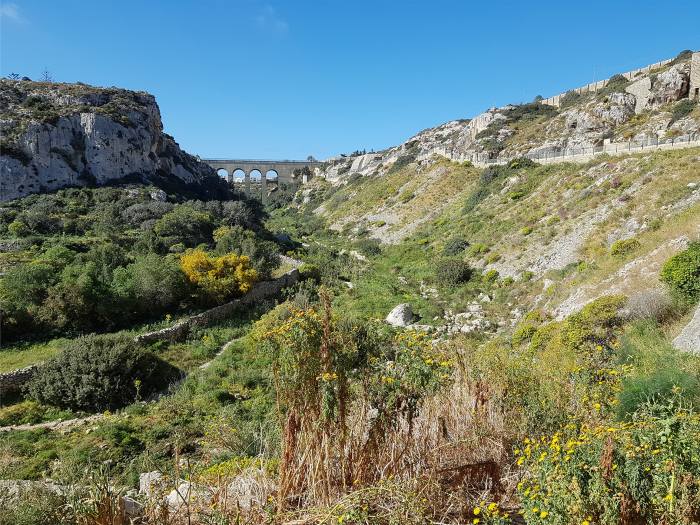
The development would be situated within a 100-meter groundwater safeguard zone and less than 30 meters from the Wied il-Għasel watercourse, posing a risk to the valley’s ecological integrity. We argued that the proposed building would negatively impact the area’s density and visual amenity, contravening several objectives of Malta’s Strategic Plan for Environment and Development. These include objectives aimed at reducing urban development density and protecting natural areas and hydrological processes. BirdLife Malta has urged the Planning Authority to reject the application and ensure the full protection of the Wied il-Għasel valley system from any harmful development.

Rare Glossy Ibis spotted at Salina Nature Reserve
A Glossy Ibis (Maltese name: Velleran) was recently spotted at Salina Nature Reserve, a rare yet captivating sight in Malta. Renowned for its iridescent plumage and distinctive curved bill, this elegant bird is typically found in wetland habitats like Simar Nature Reserve. However, the Glossy Ibis appeared quite at home at Salina, taking advantage of the reserve’s rich environment. With a diet that includes insects, small fish, and amphibians, Salina provides an ideal feeding ground for this rare visitor. You can watch a video of this remarkable bird in action here


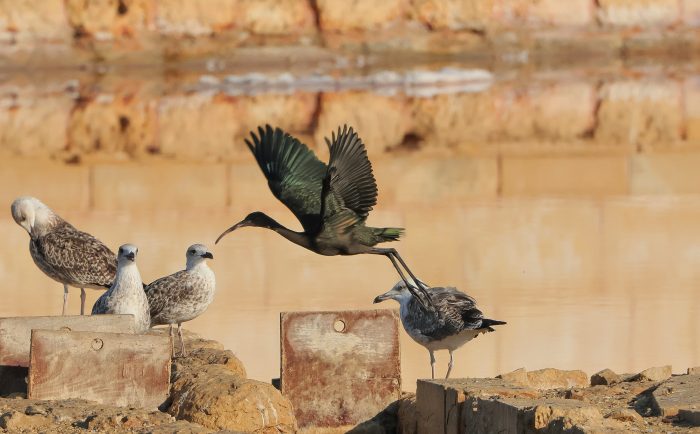
Two Great White Egrets grace Salina Nature Reserve
The Great White Egret (Ardea alba), Russett Abjad in Maltese, is a large and striking white heron species. Through it can look similar to Little Egrets it stands out due to its size— reaching up to 1 metre and with a wingspan of almost 170 cm, the same size as the Grey Heron. Other identification features to look out for include its black feet, which turn yellowish just above the joint. In breeding adults, the beak is dark while yellow with a dark tip in non-breeders and juveniles. This bird typically inhabits wetlands and marshes areas and is found across tropical and warmer temperate regions of Europe, Africa, Asia, and the Americas.
The Great White Egret was formerly a rare visitor to Malta, with sightings of individual birds. In recent years, however, there has been an increase in sightings of this elegant bird. One can come across it both during the spring and autumn migrations. Most observations are of single or small flocks mostly of up to five birds. Occasionally, it can also be seen migrating in the company of other herons.
Recently, these two Great White Egrets decided to break up their autumn migration south and graced the Salina Nature Reserve for some time, where they could be observed resting and feeding along the saltpans.
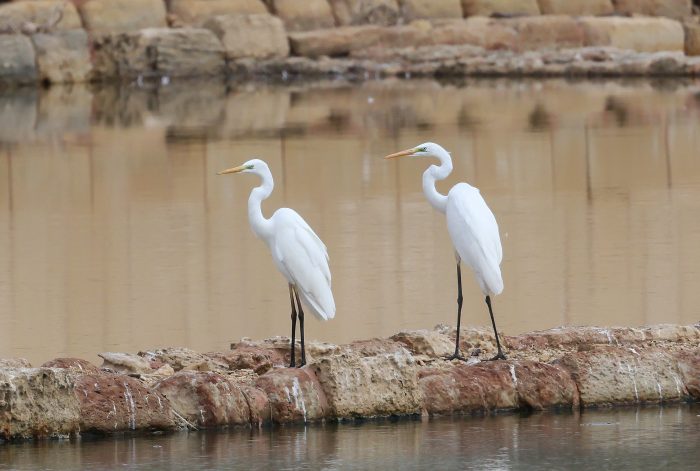
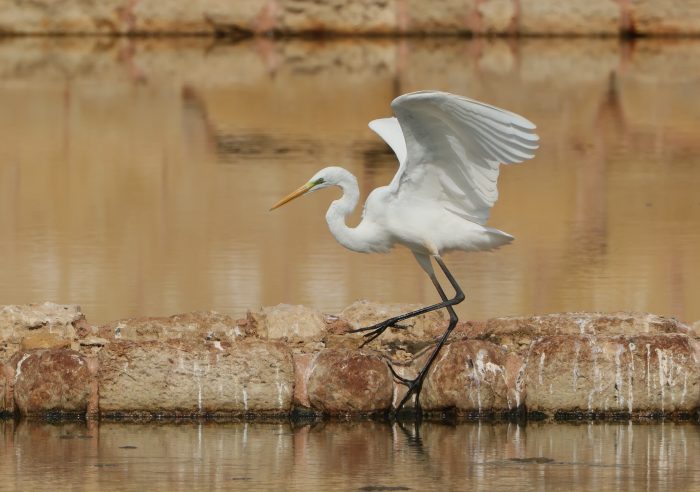

Credits
Words: Ben Chircop, Charles Coleiro, David Attard, Isabel Celeste, Justine Borg, Khouloud Belhadj, Manuel Mallia, Marcella Giornetti, Mario V Gauci, Petra Galac, Vera Tokmakova
Photographs: Alice Tribe, Aron Tanti, Charles Coleiro, Davide Attard, Isabelle Celeste, Marion L’Huillier Hunsinger, Mario V Gauci, Ray Galea, Vera Tokmakova
Editing: Khouloud Belhadj

